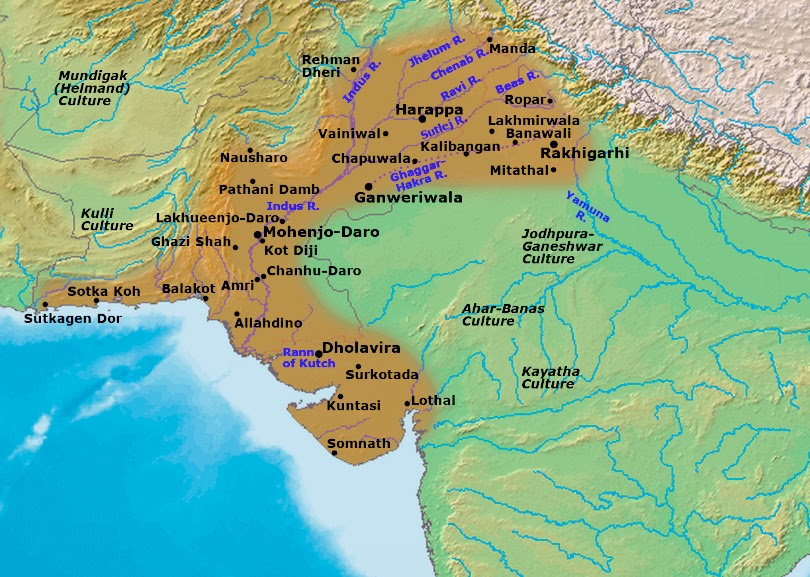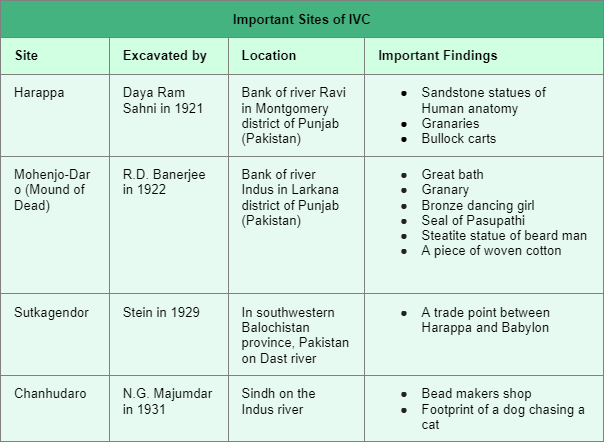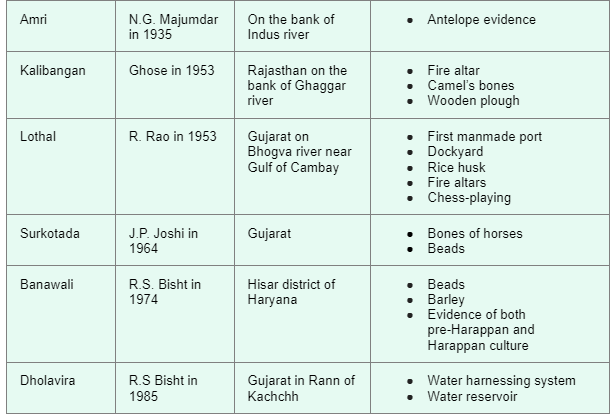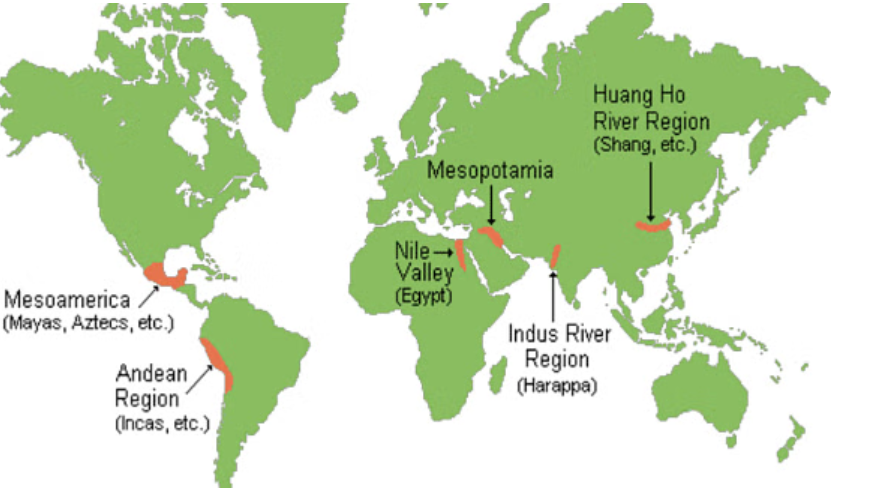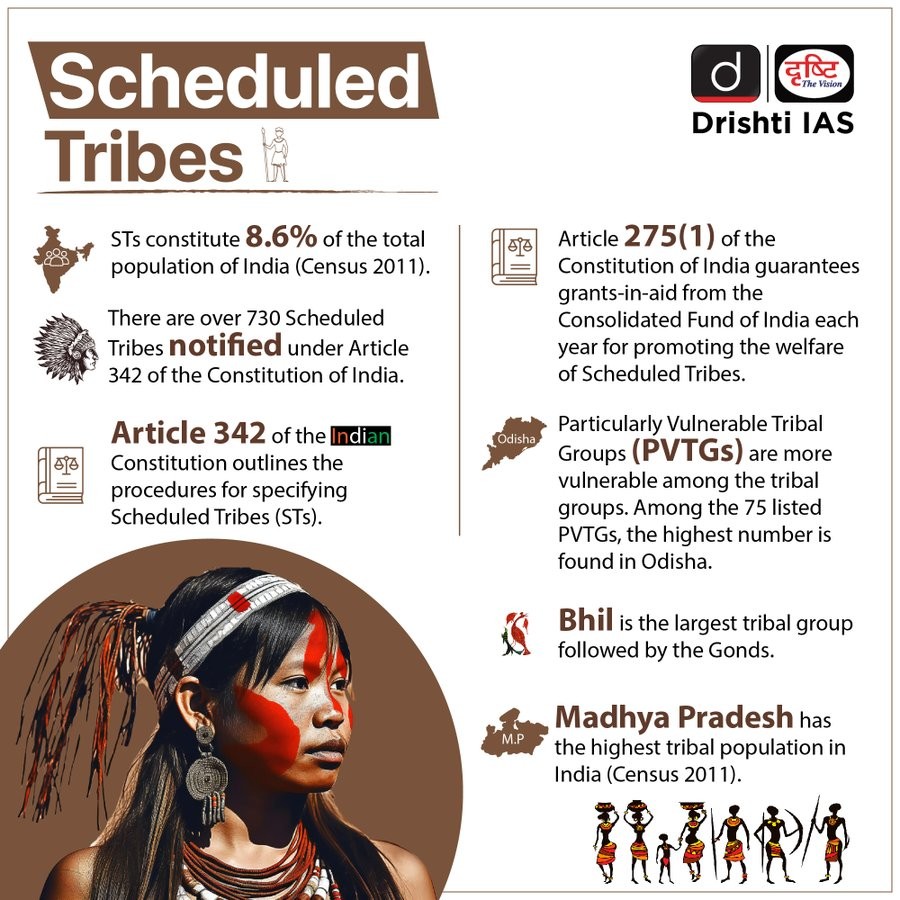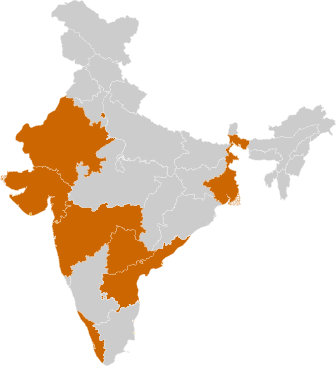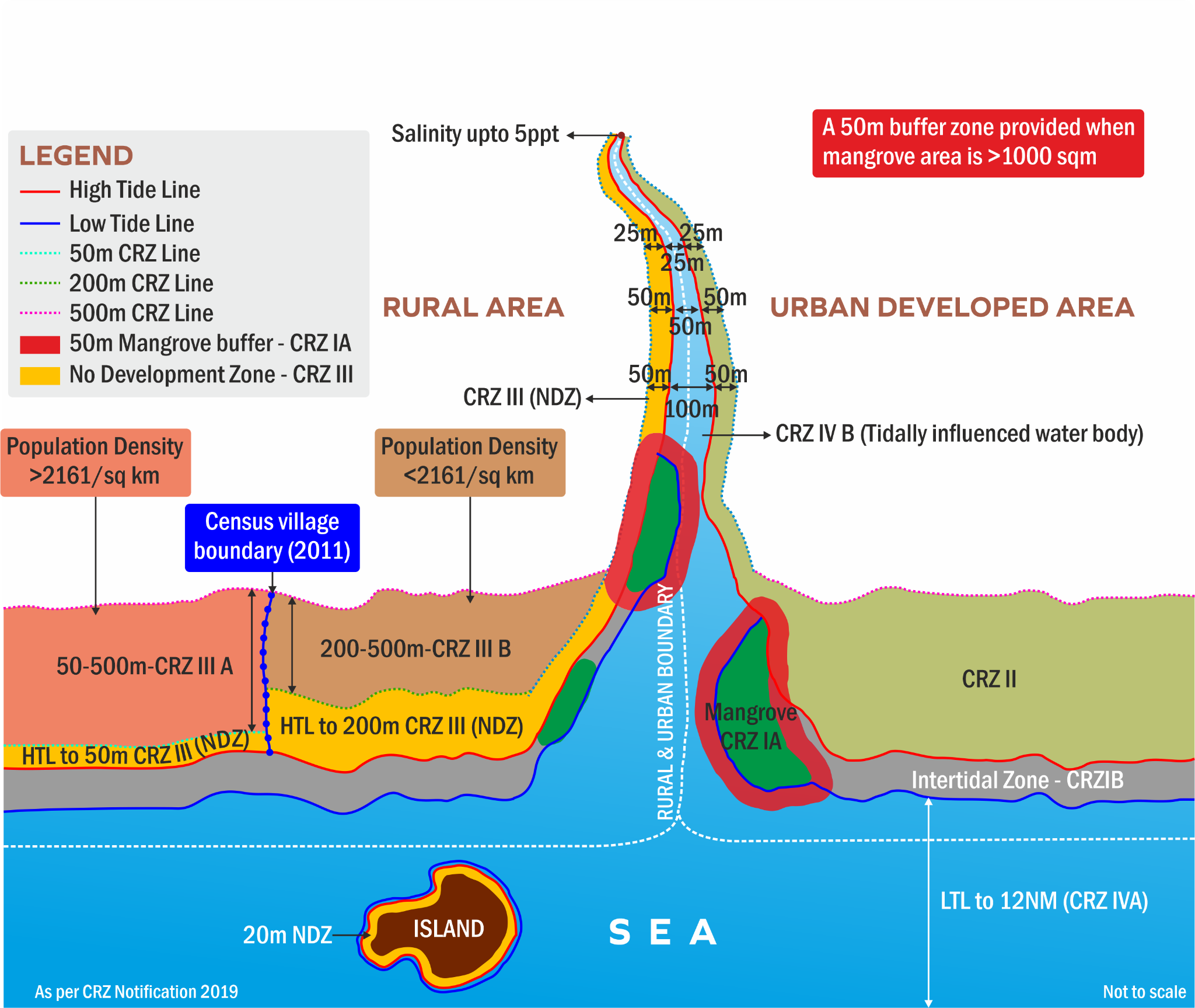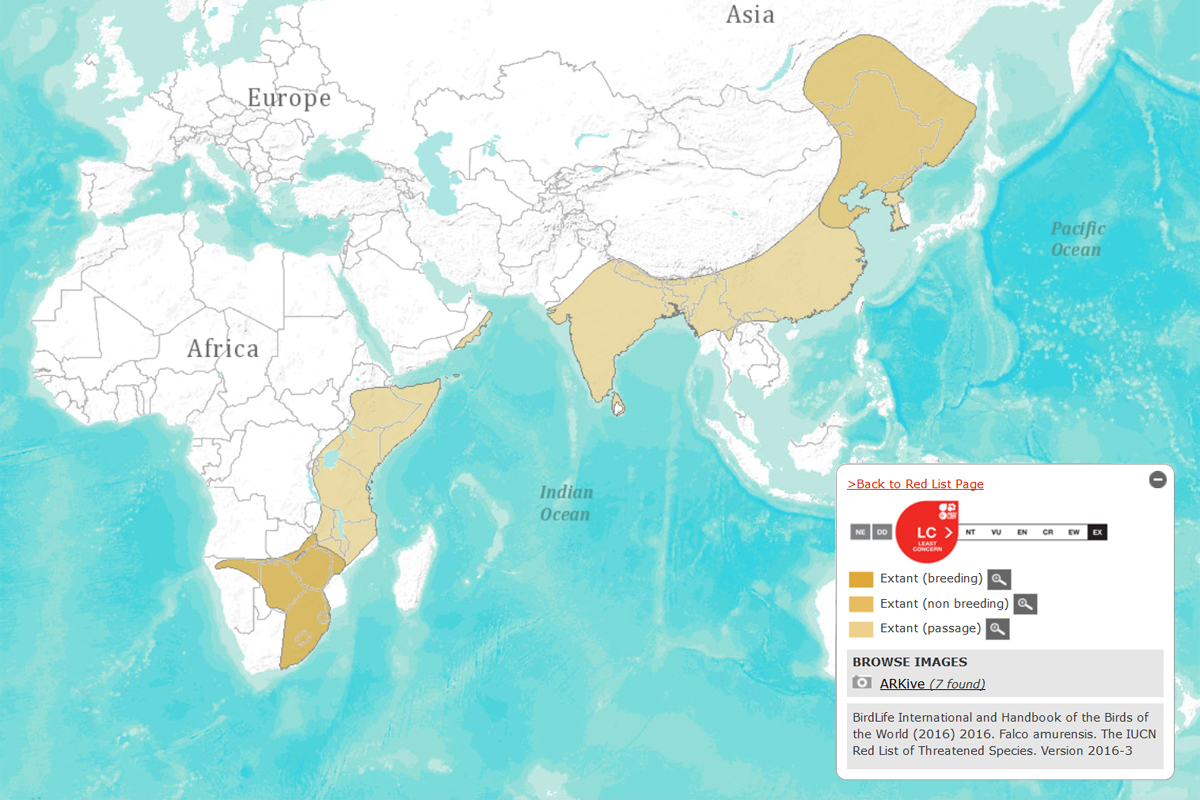100 years of Discovery of IVC
For Prelims: Harappan Civilization, Archaeological Survey of India (ASI), Indus Valley Civilization (IVC), Aryans
For Mains: Key features of Indus Valley Civilization, Town Planning, Religion and Decline of Indus Valley Civilization, Contemporary Civilizations its Key Features
Why in News?
20th September 2024, marked 100 years since the discovery of the Indus Valley Civilization, which was announced by archaeologist Sir John Marshall on 20th September 1924.
- This civilization spans over 2,000 sites across 1.5 million sq. km in India, Pakistan, and Afghanistan and is famous for its advanced urban planning and architecture.
What was Harappan Civilization?
- About:
- The Harappan Civilization, also known as the Indus Valley Civilization (IVC), flourished around 2500 BCE along the Indus River .
- It was the largest of the four ancient urban civilizations alongside Egypt, Mesopotamia, and China.
- The IVC is classified as a Bronze-age civilization due to the discovery of numerous artefacts made from copper-based alloys.
- Daya Ram Sahni first excavated Harappa in 1921-22, and Rakhal Das Banerji began excavating Mohenjo-daro in 1922.
- Sir John Marshall, DG of ASI, was responsible for the excavations that led to the discovery of Harappa and Mohenjo-Daro sites of IVC.
- Phases:
- Early phase (3200 BCE to 2600 BCE): This phase is associated with the Hakra Phase, which was discovered in the Ghaggar-Hakra River Valley. The earliest Indus script dates back to 3000 BC.
- Mature period (2600 BCE to 1900 BCE): By 2600 BC, the IVC had reached a mature stage. Early Harappan towns, like Harappa and Mohenjodaro in Pakistan and Lothal in India, were growing into major urban centres
- Late phase (1900 BCE to 1500 BCE): In this phase, Harappan civilization decayed and collapsed.
What were the Important Sites of Harappan Civilization?
What were the Key Features of Harappan Civilization?
- Town Planning:
- The Harappan culture was notable for its advanced town planning with cities designed in the grid-like layout.
- Both Harappa and Mohenjodaro featured a citadel or acropolis, likely occupied by the ruling class.
- Below these citadels lay the lower towns, consisting of brick houses inhabited by common people.
- Granaries of large size were used to store grains, and there was widespread use of burnt bricks, which is different compared to the dried bricks used in contemporary Egyptian structures.
- Mohenjodaro had an impressive drainage system, and almost all houses had courtyards and bathrooms.
- In Kalibangan, many homes even had private wells.
- At sites like Dholavira and Lothal in Gujarat, the entire settlement was fortified, with internal sections divided by walls.
- Agriculture:
- Harappan villages, primarily located near floodplains, were highly productive, yielding crops such as wheat, barley, peas, sesame, lentils, chickpeas, rai, and mustard.
- Millets were also cultivated, particularly in Gujarat, though rice was rare. The Indus people were among the first to produce cotton (Greeks called it “Sindon”).
- While agricultural activity is evidenced by grain remains, reconstructing specific farming techniques is challenging.
- In addition to farming, animal husbandry was widespread.
- Economy:
- Trade played a vital role in Harappan life, evident from the widespread use of seals, a uniform script, and standardised weights and measures.
- Major trade items included stone, metal, and shell.
- The barter system was used, as metal currency did not exist.
- Navigation was practised along the Arabian Sea coast.
- A trading colony in northern Afghanistan facilitated commerce with Central Asia.
- The Harappans engaged in trade with Mesopotamia (Tigris-Euphrates region).
- Long-distance trade in lapis lazuli (blue semi precious stone) likely enhanced the social status of the ruling class.
- Crafts:
- Harappans were skilled in bronze manufacturing, using copper from Rajasthan (Khetri mines) and tin possibly from Afghanistan.
- Textile impressions on objects suggest a knowledge of weaving.
- Key crafts included boat-making, bead-making, seal-making, and terracotta production.
- Goldsmiths crafted jewellery from gold, silver, and precious stones.
- The potter's wheel was widely used, producing glossy, distinctive pottery.
- Religion:
- Numerous terracotta figurines of women suggest worship of a fertility goddess, similar to the Egyptian goddess Isis.
- A male deity, identified as Pashupati Mahadeva (in yogi posture), is depicted on a seal with three horned heads, surrounded by animals like elephants, tigers, rhinoceros, and buffalo.
- Symbols of the phallus (male sex organ) and female sex organs indicate fertility worship.
- The Harappans worshipped animals and trees, with the unicorn (possibly a rhinoceros) and the humped bull being significant.
- Amulets were commonly found, likely used for protection or religious purposes.
What were the Possible Reasons for Decline of Harappan Civilization?
- Invasion Theory: Some scholars suggest that Indo-European tribes, known as the Aryans, invaded and overthrew the IVC. However, evidence of cultural continuity in later societies challenges this abrupt invasion narrative.
- Natural Environmental Changes: More widely accepted is the impact of environmental factors.
- Tectonic Activity: Earthquakes may have altered river courses, leading to the drying up of essential water sources.
- Changes in Rainfall Patterns: Shifts in monsoon patterns could have diminished agricultural productivity, resulting in food shortages.
- Flooding: Altered river courses might have caused flooding in key agricultural areas, further threatening the civilization’s stability.
Recent Initiatives Related to IVC Sites
- National Maritime Heritage Complex (NMHC): Under the Sagarmala programme, the Ministry of Ports, Shipping, and Waterways (MoPSW) is developing a NMHC at Lothal. It includes a museum, theme parks, a research institute, and more, to showcase India's maritime history and heritage, and attract tourists.
- Dholavira added to UNESCO's World Heritage list: In July 2021, Dholavira was named India's 40th World Heritage Site by UNESCO.
- Development of Rakhigarhi as an Iconic Site: Union Budget (2020-21) has proposed to develop Rakhigarhi (Hisar district,Haryana) as an iconic site.
UPSC Civil Services Examination, Previous Year Questions (PYQs)
Prelims
Q. Regarding the Indus Valley Civilization, consider the following statements: (2011)
- It was predominantly a secular civilization and the religious element, though present, did not dominate the scene,
- During this period, cotton was used for manufacturing textiles in India.
Which of the statements given above is/are correct?
(a) 1 only
(b) 2 only
(c) Both 1 and 2
(d) Neither 1 nor 2
Answer: (c)
Q. Which of the following characterize/characterises the people of the Indus Civilization? (2013)
- They possessed great palaces and temples.
- They worshiped both male and female deities.
- They employed horse-drawn chariots in warfare.
Select the correct statements using the codes given below:
(a) 1 and 2 only
(b) 2 only
(c) 1, 2 and 3
(d) None of the above
Ans: (b)
Mains
Q1: The ancient civilisation in the Indian sub-continent differed from those of Egypt, Mesopotamia and Greece in that its culture and traditions have been preserved without a breakdown to the present day. Comment. (2015)
Q2: To what extent has the urban planning and culture of the Indus Valley Civilization provided inputs to present-day urbanization? Discuss. (2014)
White Revolution 2.0
For Prelims: White Revolution 2.0, Malnutrition, Operation Flood, NABARD, National Dairy Development Board (NDDB), National Programme for Dairy Development (NPDD), Primary Agriculture Credit Societies (PACS), ET technology, Total Mixed Ration (TMR).
For Mains: Need of White Revolution 2.0 and technologies to achieve its objectives.
Why in News?
Recently, the Ministry of Cooperation unveiled standard operating procedure (SOPs) for White Revolution 2.0, aimed at empowering women farmers and creating job opportunities.
What are the Key Facts About White Revolution 2.0?
- About White Revolution 2.0: It is an initiative to increase milk production along with empowerment of women and the fight against malnutrition.
- It is in line with White Revolution launched in 1970 by Dr. Verghese Kurien that transformed the dairy-deficient nation into the global leader in milk production.
- White Revolution is also known as ‘Operation Flood’.
- Target under White Revolution 2.0: Dairy cooperatives are projected to procure 100 million kilograms of milk daily by the end of the 5th year of the initiative.
- It aims to increase procurement led by cooperatives from the present 660 lakh litres per day to 1,000 lakh litres.
- Launch of Margdarshika (SOPs): Margdarshika (SOPs) has been launched to form 200,000 new multipurpose primary agricultural cooperatives (MPACs).
- It will foster new cooperatives in panchayats that don’t have one for agricultural, fisheries and dairy-related activities.
- It has been prepared by the Ministry of cooperation in collaboration with NABARD, and National Dairy Development Board (NDDB).
- Women Empowerment: Maximum women are engaged in the dairy sector, generating business worth Rs 60,000 crore in Gujarat alone.
- The initiative will empower women by absorbing them in formal employment as the money will be deposited in their bank accounts.
- Tackling Malnutrition: With the increase in availability of milk, the biggest benefit will pass on to the poor and malnourished children.
- It will strengthen the fight against malnutrition by ensuring adequate nutrition for children.
- Integration with Existing and Upcoming Schemes: The plan will build on existing government schemes such as the Dairy Processing and Infrastructure Development Fund (DIDF) and the National Programme for Dairy Development (NPDD).
- A new phase, NPDD 2.0, is also proposed under the Department of Animal Husbandry and Dairying to further the cooperative agenda.
- Expansion of 'Cooperation Among Cooperatives' Initiative: The government launched the nationwide expansion of the ‘Cooperation among Cooperatives’ initiative, which was piloted successfully in Gujarat.
- It allows dairy farmers to access interest-free cash credit via RuPay Kisan Credit Cards and will distribute micro-ATMs to bring financial services to rural areas.
- PACS Computerisation: Standard operating procedures (SOPs) for the computerisation of Primary Agriculture Credit Societies (PACS) was launched to modernise PACS, ensuring more efficient and transparent operations.
What is the Current Status of Milk Production in India?
- Global Ranking: India is the world’s top milk producer, with production having reached 231 million tonnes during 2022-23.
- In 1951-52, the country produced just 17 million tonnes of milk.
- Top Milk-Producing States: As per the Basic Animal Husbandry Statistics (BAHS) 2023, the top five milk producing states are UP (15.72%), Rajasthan (14.44%), Madhya Pradesh (8.73%), Gujarat (7.49%), and Andhra Pradesh (6.70%), which together contribute 53.08% of the country’s total milk production.
- Per Capita Availability of Milk: The national per capita availability of milk is 459 grams/ day, which is higher than the global average of 323 g/day.
- However, it varies from 329 g in Maharashtra to 1,283 g in Punjab.
- Milk Production by Animal Type: Almost 31.94% of the total milk production comes from indigenous buffaloes, followed by 29.81% from crossbred cattle. The share of goat milk is 3.30%, and that of exotic cows, 1.86%.
- Contribution of Dairy to the Agriculture and Livestock Sector: The milk group (milk, ghee, butter, and lassi) contributed approximately 40% of the total output value from agriculture, livestock, forestry, and fishing sectors in 2022-23.
- This amounted to Rs 11.16 lakh crore, making it a much larger contributor than cereals to the agricultural sector.
What is the Need of White Revolution 2.0?
- To Increase Milk Productivity: The average yield is only 8.55 kg per animal per day for exotic/crossbred animals, and 3.44 kg/animal/day for indigenous animals.
- The yield in Punjab is 13.49 kg/ animal/ day (exotic/ crossbreed), but only 6.30 kg/ animal/ day in West Bengal.
- Reversing the Decline in Annual Growth Rate of Milk Production: The growth rate decreased from 6.47% in 2018-19 to 3.83% in 2022-23, indicating a deceleration in the rate of increase in milk production.
- Formalisation of Milk Consumption Pattern: About 63% of the total milk production comes to the market; the remaining is kept by producers for their own consumption.
- About two-thirds of the marketable milk is in the unorganised sector.
- In the organised sector, cooperatives account for the major share.
- Milk as the Top Food Expenditure in India: In rural India, the average monthly expenditure on milk per person was Rs 314, surpassing other food items like vegetables, cereals, and eggs.
- Similarly, in urban India, milk expenditure was Rs 466, higher than fruits, vegetables, cereals, and meat.
- Checking Rising Milk Prices: The all-India modal price of milk increased from Rs 42 to Rs 60 per litre over the past five years due to rising input costs, including fodder and feed.
- There is concern that further price increases may lead to demand destruction, as consumers may find milk unaffordable.
- Methane Emissions: Livestock emissions from manure and gastroenteric releases account for roughly 32% of human-caused methane emissions which is a major cause of global warming.
How can Milk Production be Increased Under White Revolution 2.0?
- Genetic Improvement: The introduction of sex-sorted (SS) semen can increase the probability of female calves with higher milk productivity, such as Kankrej and Gir, being born to 90%, thereby boosting the number of future milk-producing cows.
- Sex-sorted (SS) semen allows for the production of offspring of a desired sex e.g., only female calves.
- Embryo Transfer (ET) Technology: ET technology can further enhance the productivity of high-genetic-merit (HGM) cows by allowing multiple embryos to be produced and implanted into different surrogate cows.
- Through this method, a single HGM cow can potentially produce 12 calves per year, compared to 5-7 calves over its lifetime through normal breeding.
- In Vitro Fertilisation (IVF) Technology: In IVF technology, immature ova are extracted, fertilised in a lab, and then implanted in surrogate cows.
- It can produce 33-35 calves per donor cow per year, allowing for a quicker scaling of the cow population with high milk yields.
- Nutrition and Feed Intervention at Low Cost: Along with genetic improvement, interventions in animal nutrition are essential to reduce feed costs.
- Amul is setting up a Total Mixed Ration (TMR) plant in Gujarat, which will produce affordable ready-to-eat fodder mixes consisting of maize, jowar, and oat grass for animals.
- TMR is a feeding method that combines forages, grains, proteins, minerals, vitamins, and additives into a single nutrient-rich feed for cows.
- Improved Diet Quality: Providing easily digestible forages like legumes and grains reduces fermentation time, lowering methane production.
- Specific feed additives can directly inhibit the microbes responsible for methane production.
- Released methane can be further used for biogas production.
What are the Related Schemes for the Livestock Sector?
- Animal Husbandry Infrastructure Development Fund (AHIDF)
- National Animal Disease Control Programme
- Rashtriya Gokul Mission
- National Artificial Insemination Programme
- National Livestock Mission
Conclusion
White Revolution 2.0 aims to transform India’s dairy sector by enhancing milk production, empowering women farmers, and lowering production costs through genetic improvements, embryo transfer (ET), and in vitro fertilisation (IVF). With a focus on reducing feed expenses and increasing milk yield, it ensures sustainable growth while maintaining affordability, boosting farmer incomes, and strengthening the rural economy.
|
Drishti Mains Question: What role can technology play in enhancing dairy production in India under White Revolution 2.0? |
UPSC Civil Services Examination, Previous Year Question (PYQ)
Mains
Q. Explain various types of revolutions, took place in Agriculture after Independence in India. How have these revolutions helped in poverty alleviation and food security in India? (2017)
PM Janjatiya Unnat Gram Abhiyan
For Prelims: Pradhan Mantri Janjatiya Unnat Gram Abhiyan (PMJUGA), Tribal Communities, Development Action Plan for Scheduled Tribes (DAPST), Poshan Abhiyan, Forest Rights Act, 2006 (FRA), Immunisation, Swadesh Darshan scheme, Sickle cell Disease, Pradhan Mantri Adi Adarsh Gram Yojana.
For Mains: Government policies & interventions for welfare of tribal communities.
Recently, the Union Cabinet approved Pradhan Mantri Janjatiya Unnat Gram Abhiyan (PMJUGA) for improving the socio-economic condition of tribal communities.
What are the Key Facts About the PMJUGA?
- About PMJUGA: It is a centrally sponsored scheme for the welfare of tribal families in tribal-majority villages and aspirational districts.
- Target Areas and Coverage: It will cover 549 districts and 2,740 blocks spread across all tribal majority villages across 30 States/UTs.
- It will cover around 63,000 villages benefitting more than 5 crore tribal people.
- According to the 2011 Census, India has a Scheduled Tribe (ST) population of 10.42 crore (8.6%), consisting of over 705 tribal communities.
- Objective: It envisions fulfilling critical gaps in social infrastructure like health, education, livelihood, through different schemes of Government of India by convergence and outreach.
- Goals of the Mission: It comprises 25 interventions which will be implemented by 17 ministries through funds allocated to them under the Development Action Plan for Scheduled Tribes (DAPST) in the next 5 years to achieve the following goals.
- Developing Enabling Infrastructure:
- Pucca house for Eligible Households with Other Entitlements: Eligible ST households shall have access to pucca housing under the PMAY (Rural) with availability of tapped water (Jal Jeevan Mission) and electricity supply. Eligible ST households shall also have access to Ayushman Bharat Card (PMJAY).
- Improving Village Infrastructure: Ensuring all weather road connectivity to ST majority villages (PMGSY), providing access to mobile connectivity (Bharat Net) and internet, infrastructure for improving health, nutrition, and education (National Health Mission, Samagra Shiksha and Poshan Abhiyan).
- Promotion of Economic Empowerment: It focuses on skill development, entrepreneurship promotion and enhanced livelihood (self-employment) through providing access to training (Skill India Mission), marketing support from the Tribal Multipurpose Marketing Centre (TMMC) and assistance in agriculture, animal husbandry, and fishery sectors for Forest Rights Act, 2006 (FRA) patta holders.
- Universalisation of Access to Quality Education: Efforts will be made to increase the Gross Enrollment Ratio (GER) in school and higher education and make quality education affordable and accessible to ST students (Samagra Shiksha Abhiyan) by setting up tribal hostels in schools at district/block level.
- Healthy lives and Dignified Ageing: It aims to reach towards the national standards in IMR, MMR and coverage of immunisation through Mobile Medical Units in areas where the sub centre is more than 10 km in plain areas and 5 kms in Hilly areas.
- Developing Enabling Infrastructure:
- Mapping and Monitoring: The tribal villages covered under the mission would be mapped on PM Gati Shakti Portal with the gaps identified by the concerned ministry for its scheme specific requirements and the best performing districts will be awarded.
Note:
- The DAPST is a strategy for tribal development in India. The Ministry of Tribal Affairs and 41 other ministries and departments allocate funds to tribal development projects under DAPST.
- These projects include education, health, agriculture, irrigation, roads, housing, electrification, and employment.
What are the Innovative Schemes to Promote Livelihood amongst Tribals under PMJUGA?
- Tribal Home Stay: To boost tourism in tribal areas and provide alternative livelihoods, the Ministry of Tourism will promote 1,000 homestays under the Swadesh Darshan scheme.
- Villages with tourist potential will receive funding for 5-10 homestays, with each household eligible for Rs 5 lakh to build two new rooms, up to Rs 3 lakh for renovating existing rooms, and Rs 5 lakh for community needs.
- Sustainable Livelihood for Forest Right Holders: The mission places a special focus on 22 lakh Forest Rights Act, 2006 patta holders in forest areas. It aims to expedite the recognition of forest rights, empower tribal communities, and provide sustainable livelihoods through various governmental schemes.
- Improving infrastructure of Govt residential Schools and Hostels: The initiative includes improving the infrastructure of tribal residential schools, hostels, and ashram schools to enhance local educational resources, promote enrollment, and retain students in these institutions.
- Advanced facilities for diagnosis of Sickle Cell Disease: Centre of Competence (CoC) would be set up in AIIMS and premier Institutes in the States where Sickle cell disease is prevalent.
- CoC shall have the latest facilities, technology, personnel and research capabilities for prenatal diagnosis, at a cost of Rs 6 crore/CoC.
- Tribal Multipurpose Marketing Centre (TMMCs): 100 TMMCs will be set up for effective marketing of tribal products and for improving marketing infrastructure, awareness, branding, packaging, and transportation facilities.
What is the Need of PMJUGA?
- Poverty: Tribal communities often live in poverty, with limited access to resources. The erstwhile Planning Commission estimated that the percentage of ST individuals living below the poverty line was 45.3% (2011-12) in rural areas and 24.1% (2011-12) in urban areas.
- Under PMJUGA, Skilling Centers will be opened in tribal districts for employment generation and reduction in poverty.
- Land Rights and Displacement: Many tribal communities face displacement due to development projects, mining, and deforestation. The tribal population often lacks formal land titles, leading to insecure tenure and exploitation.
- PMJUGA will issue 22 lakh FRA pattas under Scheduled Tribes and Other Traditional Forest Dwellers (Recognition of Forest Rights) Act, 2006 in recognition of their land rights.
- Low Literacy Rate: Literacy rates among tribal populations are significantly lower than the national average.
- As per Census 2011, literacy rate of Scheduled Tribes (STs) was 59% whereas the overall literacy rate was 73% at all India level.
- 1000 hostels will be constructed under the Samagra Shiksha Abhiyan (SSA) for affordable education.
- Health Issues: As per the recent report of National Family Health Survey (NFHS-5) 2019-21, the prevalence of stunting, wasting and underweight among tribal children is 40.9%, 23.2% and 39.5% respectively. It is significantly higher than the national average of 35.5%, 19.3% and 32.1%.
- High incidence of Sickle Cell Disease (SCD) is also seen among the tribal people.
- The Ministry of Health and Family Welfare will provide Mobile Medical Units under the National Health Mission.
- Cultural Erosion and Identity: Many tribal communities struggle to maintain their traditional practices amidst external pressures like rapid urbanisation and globalisation.
- Under Pradhan Mantri Adi Adarsh Gram Yojana, model villages will be created while preserving cultural identity.
- Lack of Awareness about Government Schemes: Despite their poverty, many tribal people are largely unaware of BPL cards, ration cards, or job cards for 100-day employment schemes. As a consequence, they remain deprived from such benefits.
- The Ministry of Electronics & Information Technology will promote various Digital India initiatives for awareness generation.
What are the Other Government Initiatives for Scheduled Tribes?
- PM-Janjati Adivasi Nyaya Maha Abhiyan (PM-JANMAN) Scheme
- TRIFED
- Digital Transformation of Tribal Schools
- Development of Particularly Vulnerable Tribal Groups
- Pradhan Mantri Van Dhan Yojana
- Eklavya Model Residential Schools
Conclusion
The Pradhan Mantri Janjatiya Unnat Gram Abhiyan (PMJUGA) aims to uplift tribal communities through sustainable development, enhancing infrastructure, livelihoods, and access to services. By promoting skill development and self-sufficiency, it seeks to improve education, healthcare, and overall quality of life, bridging the development gap and empowering tribal voices in India.
|
Drishti Mains Question: Examine the key challenges faced by tribal communities in India. What are the various government schemes and policies to address these issues. |
UPSC Civil Services Examination Previous Year Question (PYQ)
Prelims
Q.Under which Schedule of the Constitution of India can the transfer of tribal land to private parties for mining be declared null and void? (2019)
(a) Third Schedule
(b) Fifth Schedule
(c) Ninth Schedule
(d) Twelfth Schedule
Ans: (b)
Q.The Government enacted the Panchayat Extension to Scheduled Areas (PESA) Act in 1996. Which one of the following is not identified as its objective? (2013)
(a) To provide self-governance
(b) To recognize traditional rights
(c) To create autonomous regions in tribal areas
(d) To free tribal people from exploitation
Ans: (c)
Mains
Q. How do you explain the statistics that show that the sex ratio in Tribes in India is more favourable to women than the sex ratio among Scheduled Castes? (2015)
Need of Reforms in Diamond Sector
For Prelims: Diamond, Rough Diamonds, Gross Domestic Product (GDP), Employment, Foreign Direct Investment (FDI), Reserve Bank of India (RBI), Inflation, Lab-Grown Diamonds, Interest Rate, Corporate Tax, Special Notified Zones (SNZs), India-UAE Comprehensive Economic Partnership Agreement (CEPA).
For Mains: Importance of Gems and Jewellery Industry for India, Associated challenges and way forward.
Why in News?
According to the think tank Global Trade Research Initiative (GTRI), India's diamond sector is experiencing a major downturn, marked by significant declines in imports and exports over the past three years.
- It has led to defaults, factory closures, and widespread job losses for which reforms in the diamond sector are needed.
What is the Current State of Crisis in India's Diamond Industry?
- Sharp Decline in Diamond Imports and Exports: Rough diamond imports fell by 24.5%, from USD 18.5 billion in FY 2021-22 to USD 14 billion in FY 2023-24.
- Exports of cut and polished diamonds dropped by 34.6%, from USD 24.4 billion in FY 2022 to USD 13.1 billion in FY 2024.
- High Inventory of Unprocessed Rough Diamonds: The gap between net imports of rough diamonds and net exports of cut and polished diamonds has widened significantly, from USD 1.6 billion in FY 2022 to USD 4.4 billion in FY 2024.
- Rough Diamonds refer to diamonds which are still in their natural state after being removed from the earth and before being shaped and polished.
- Increased Returns of Unsold Diamonds: The percentage of unsold diamonds returned to India rose from 35% to 45.6% during the period from FY 2022 to FY 2024.
- Impact on Employment and Factory Closures: The industry, which provides direct employment to 1.3 million workers, has been hit hard leading to joblessness and suicides.
What is the Importance of Gems and Jewellery Industry for India?
- Contribution to India’s Economy: As of January 2022, the gold and diamond trade accounted for approximately 7% of India’s Gross Domestic Product (GDP), showcasing its significant role in the national economy.
- Employment: The gems and jewellery sector employs around 5 million people, making it a crucial industry for job creation in India.
- The Indian diamond industry comprises over 7,000 companies, mainly small and medium enterprises (SMEs), concentrated in Surat in Gujarat, and Mumbai in Maharashtra.
- Surat, Mumbai, Jaipur, Thrichor, Nellore, Delhi, Hyderabad and Kolkata are the major hubs for gems and jewellery in India.
- Surat alone employs about 800,000 workers in diamond cutting and polishing.
- FDI Policy: The Government has allowed 100% Foreign Direct Investment (FDI) in the gems and jewellery sector under the automatic route.
- Between April 2000 and March 2024, cumulative FDI inflows into India’s diamond and gold ornaments sector totaled USD 1,276.52 million.
- Growth and Export Performance: In FY2021, the size of India’s gems and jewellery market stood at USD 78.50 billion.
- In FY24, India's gems and jewellery exports were at USD 22.27 billion, reflecting the sector's resilience despite global challenges.
What are the Reasons for the Crisis in India's Diamond Industry?
- Economic Uncertainty: Demand for polished diamonds has dropped sharply in key markets like the US, China, and Europe due to economic uncertainty, inflation, and geopolitical tensions, leading to reduced consumer spending on luxury goods, including diamonds.
- Russia-Ukraine Conflict: The Russia-Ukraine conflict has also disrupted the global diamond supply chain, with sanctions on Russia, a major rough diamond producer.
- It further complicated trade and slowed down the global diamond trade.
- Fluctuations in Prices: Fluctuations in global diamond prices have caused uncertainty, with buyers hesitant to purchase rough diamonds in anticipation of further price drops.
- Preferences to Lab-Grown Diamonds: Consumer preferences are shifting toward lab-grown diamonds, which are more affordable, ethical, and sustainable. It is also impacting the demand for natural diamonds.
- Lab grown diamonds are man made diamonds that are chemically and optically identical to natural mined diamonds.
- Rising Operational Costs: Rising operational costs (high labour, energy, and materials cost) and reduced profit margins in the global diamond trade, have made it difficult for many polishing units to remain viable.
- It has led to shop closures and layoffs, especially in Surat.
- Tighter Credit Conditions: The diamond industry is heavily dependent on financing, but tighter credit conditions like higher interest rates and reduced lending from banks have made it difficult for companies to purchase rough diamonds, stalling production further.
- Regulatory Issues: India’s high corporate tax regime on foreign suppliers of rough diamonds has led to more rough diamonds being re-exported from UAE, rather than India thus weakening India’s Special Notified Zones (SNZs) in Mumbai and Surat.
- UAE imports rough diamonds from Botswana, Angola, South Africa, Russia and re-exports these to India.
- As a result, UAE’s share in India’s rough diamond imports has surged, from 36.3% in FY 2020 to 64.5% in the first quarter of FY 2024, while Belgium’s share fell from 37.9% to 17.6% during the same period.
- UAE enjoys zero tariff on cut and polished diamonds exported to India under the India-UAE Comprehensive Economic Partnership Agreement (CEPA).
- Complex Customs Procedures: A significant portion of cut and polished diamonds exported from India are being returned due to quality issues, overstocking by buyers etc.
- Handling these returns is costly and time-consuming due to complex customs procedures, putting further strain on exporters.
What can be Done to Address the Crisis in India's Diamond Industry?
- Extend Export Credit Terms: The Reserve Bank of India (RBI) could extend the export credit period for cut and polished diamond exporters from 6 to 12 months, as buyers demand longer credit terms.
- The export credit period refers to the duration for which credit is extended to exporters to finance their export operations.
- Exempt Foreign Diamond Sellers from Corporate Tax: GTRI suggests exempting foreign sellers of rough diamonds from corporate tax in India, as the current tax structure pushes sellers to re-routing it through the UAE.
- Regulate the Lab-Grown Diamond Industry: The rising demand for lab-grown diamonds requires regulation to ensure a fair and sustainable market for natural diamonds.
- Reconsider Zero Tariff Import from Dubai: The zero tariff on cut and polished diamonds imported from UAE under the India-UAE trade pact needs to be reconsidered to protect the domestic diamond industry.
- Shift towards Organised Players: Large retailers and organised players can offer a wider variety of designs and products and help in expanding India’s gems market both domestically and internationally.
|
Drishti Mains Question: Examine the importance of the Gems and Jewellery Industry for India’s economy. Also, analyse the key challenges it is facing in recent times. |
UPSC Civil Services Examination, Previous Year Question (PYQ)
Prelims
Q.Which one of the following foreign travellers elaborately discussed about diamonds and diamond mines of India? (2018)
(a) Francois Bernier
(b) Jean-Baptiste Tavernier
(c) Jean de Thevenot
(d) Abbe Barthelemy Carre
Ans: (b)
Salt Pans Land
Why in News?
Recently, the Centre approved the transfer of 256 acres of salt pan land in Mumbai to the Dharavi Redevelopment Project Pvt Ltd (DRPPL) for building rental housing for slum dwellers.
- Environmentalists raised ecological concerns about construction on salt pan lands.
What are Salt Pan Lands?
- About:
- Salt pans are low-lying tracts of land where seawater periodically flows in, leaving behind deposits of salt and minerals.
- This natural process plays a critical role in maintaining the balance of coastal ecosystems.
- Protection Status:
- Under the CRZ Notification of 2011, these ecologically sensitive areas are classified under CRZ-1B and restrict economic activities except salt extraction and natural gas exploration.
- Salt Pans in India:
- In Mumbai, a total of 5,378 acres have been designated as salt pan lands.
- On a national scale, around 60,000 acres of salt pan lands are identified, distributed across states like Maharashtra, Andhra Pradesh, Tamil Nadu, Odisha, Gujarat, and Karnataka.
- Andhra Pradesh has the largest expanse (20,716 acres), followed by Tamil Nadu (17,095 acres) and Maharashtra (12,662 acres).
Coastal Regulation Zone (CRZ)
- The CRZ was first notified in 1991 by the Ministry of Environment and Forests (MoEF) under the Environment Protection Act of 1986. The CRZ is categorized into five zones: CRZ-I, CRZ-II, CRZ-III, CRZ-IV, and CRZ-V.
- CRZ-I are ecologically sensitive areas like mangroves, coral reefs, biosphere reserves etc.
- CRZ-II includes built-up areas – villages and towns that are already well established.
- CRZ-III are areas that are undisturbed and do not fall under either in Category I or II.
- CRZ-IV is the aquatic area from low tide line up to territorial limits.
- CRZ is an area near the coastline that's governed by rules to protect the environment and promote sustainable development. The CRZ includes:
- It is the land between the high tide line (HTL) and the low tide line (LTL).
- A 100-metre stretch along the banks of rivers, estuaries, backwaters, and creeks that are affected by tides.
- The river banks on either side of estuaries.
What is the Significance of Salt Pans?
- Environmental: Alongside the coastal mangroves, salt pans form a vital ecological barrier that mitigates flooding risks.
- Economic: Salt pans provide employment for a large number of workers, especially in rural and coastal areas. Labourers engage in activities like harvesting, processing, and transporting salt.
- Raw Material: Salt produced in salt pans is essential for various industries, including chemical production (e.g., chlorine, caustic soda), agriculture (as animal feed), and water treatment.
- Tourism Attraction: Some salt pans, especially those with scenic landscapes, have become tourist destinations, adding economic value through ecotourism and cultural tourism.
What are Welfare Schemes the Government Initiated for Salt Workers?
- Scheme for Grant of Rewards to the Children of Salt Labourers: It provides financial rewards to students for their educational development.
- Namak Mazdoor Awas Yojana (NMAY): It provides for the construction of houses for salt workers. It promotes cooperative societies in the salt industry.
- Salt Commissioner's Organization (SCO): It monitors the development of the salt industry, including planning, facilitating technology upgradation, and conducting training programs for salt workers.
UPSC Civil Services Examination, Previous Year Question (PYQ)
Prelims
Q. Among the following, who are the Agaria Community?(2009)
(a) A traditional toddy tappers community of Andhra Pradesh
(b) A traditional fishing community of Maharashtra
(c) A traditional silk-weaving community of Karnataka
(d) A traditional salt pan workers community of Gujarat
Ans: (d)
Mains
Q. The effective management of land and water resources will drastically reduce the human miseries. Explain. (2016)
PM E-DRIVE Excludes Electric Cars
Why in News?
The PM Electric Drive Revolution in Innovative Vehicle Enhancement (PM E-DRIVE) Scheme excludes electric cars from any direct subsidies.
- The government believes other measures, such as lower GST for electric cars are adequate to support the sector.
What is the PM E-DRIVE Scheme?
- About PM E-DRIVE Scheme: It is aimed at promoting electric mobility in India having a financial outlay of Rs 10,900 crore over two years.
- It has been launched to replace FAME II.
- Scope: It offers fiscal incentives to around 25 lakh electric two-wheelers, 3 lakh electric three-wheelers, and 14,000 electric buses through demand incentives.
- Automakers can claim reimbursements for eligible electric vehicle (EV) sales, similar to the previous FAME-II scheme.
- However, electric cars are notably excluded from the subsidy.
- Other Provisions: Installation of Electric vehicle public charging stations (EVPCS) in selected cities and on selected highways.
- Test agencies to be modernised to deal with the new and emerging technologies to promote green mobility.
What was the FAME Scheme?
- The FAME (Faster Adoption and Manufacturing of Hybrid and Electric Vehicles) policy aimed to reduce vehicular emissions, decrease fuel consumption, and encourage sustainable transportation.
- It was introduced in 2015 under the National Electric Mobility Mission Plan (NEMMP).
- Key Phases:
- FAME I (2015-2019): Focused on providing incentives for the purchase of electric and hybrid vehicles and supported the development of charging infrastructure.
- It aimed to promote cleaner mobility in public and private sectors.
- FAME II (2019-2024): Expanded the scope, providing USD 1.19 billion to encourage the adoption of electric vehicles, particularly in public transport (e-buses, 2-wheelers, and 3-wheelers).
- It also emphasised building a robust charging infrastructure and targeted reducing emissions from commercial fleets.
- FAME I (2015-2019): Focused on providing incentives for the purchase of electric and hybrid vehicles and supported the development of charging infrastructure.
What are Key Facts About Promotion of Electric Cars?
- Impact of Exclusion of Electric Cars in PM E-DRIVE: The absence of fiscal incentives following the end of FAME-II has led to a decline in electric car sales.
- Between April and August 2024, registrations of electric cars dropped by 9% compared to the preceding months when FAME-II was active.
- Inadequate Charging Infrastructure: According to the Bureau of Energy Efficiency, India has approximately 25,000 public charging stations for its 46 lakh registered EVs.
- The current ratio of 184 EVs per charging station is much higher than in other countries actively promoting e-mobility.
- Supporting Measures Beyond Subsidies:
- Production Linked Incentive (PLI) Schemes: The government is supporting the EV sector through PLI schemes for auto components and advanced cell chemistry (ACC) batteries.
- These incentives could help lower production costs by fostering economies of scale, especially in the EV supply chain.
- Lower GST and State-Level Exemptions: Electric cars continue to benefit from a lower Goods and Services Tax (GST) rate of 5%, compared to 28% on hybrid and CNG vehicles, and 49% on internal combustion engine vehicles.
- Production Linked Incentive (PLI) Schemes: The government is supporting the EV sector through PLI schemes for auto components and advanced cell chemistry (ACC) batteries.
World Rhino Day 2024
On the occasion of World Rhino Day 2024, the Prime Minister has reiterated the commitment towards rhino protection.
- About:
- It is celebrated annually on September 22 to raise awareness about the five endangered rhino species: Javan, Sumatran, Black, Greater One-Horned, and White rhinos.
- Theme for 2024 – Keep the Five Alive, emphasising the importance of protecting all five rhino species
- Historical Reference:
- Zaheeruddin Muqqqhammad Babur of the Mughal Empire, is recorded to have hunted rhinoceros in the northern regions of India and present-day Pakistan.
- The rhinoceros is mentioned in four distinct passages of Baburnama, Babur's autobiography, highlighting the animal's presence during his hunting expeditions.
Read More: State of the Rhino 2023
Amur Falcon
Recently, the Tamenglong district administration in Manipur imposed an immediate ban on hunting, catching, killing, and selling Amur falcons (Falco amurensis) in preparation for their arrival.
- About Amur Falcons:
- They are small and agile birds (raptors) locally known as ‘Kahuaipuina’ in Manipur and ‘Molulem’ in Nagaland (Amur Falcon capital of the world).
- Their distinctive features include dark plumage, white wing linings, and reddish-orange eyes and feet.
- Migration:
- They migrate from Northern China, Eastern Mongolia, and Far East Russia to South Africa, covering a distance of approximately 22,000 kilometres and passing through India.
- Feeding: They are insectivorous but may also consume small vertebrates.
- Threat:
- They face threats from habitat loss, hunting, and illegal trapping.
- Conservation Program:
- In 2016, Manipur tagged Amur falcons with radio transmitters to monitor their migration routes.
- An annual ‘Amur Falcon Festival’ is held in Tamenglong district to raise awareness and celebrate these birds.
- Legal Protection:
- IUCN Red List- Least Concern
- Convention on Migratory Species (CMS): Appendix II
- Wildlife Protection Act, 1972: Schedule IV
Read More: Amur Falcon - Drishti IAS
India Won Gold at 45th Chess Olympiad
Recently, Indian Chess men's and women's teams won the gold medals at the Chess Olympiad held in Budapest.
- The Indian men's team defeated Slovenia with a score of 3.5-0.5 in the 11th and final round of the 45th Chess Olympiad.
- Simultaneously, the Indian women's team dominated Azerbaijan, securing victory with a 3.5-0.5 margin.
- Prior to India, only China and the erstwhile Soviet Union had achieved the distinction of winning both men's and women's gold medals in the same edition of the Chess Olympiad.
- The Indian men's team had previously secured two bronze medals, in the 2014 and 2022 editions of the tournament.
- The Indian women's team had earned a bronze medal in the 2022 edition, which was held in Chennai.
- Chess Olympiad:
- It is a biennial event in which teams representing nations of the world compete. FIDE organises the tournament and selects the host nation.
- The first Olympiad was unofficial and was held in 1924.
Read More: International Chess Federation (FIDE)
Government Announces Measures to Resolve Shipping Woes
An inter-ministerial meeting led by the Union Minister of Commerce & Industry addressed concerns over rising freight costs, container shortages, and port congestion.
- Key Decisions from the Meeting: Significant reductions in shipping costs with measures like allowing free storage of empty containers at Jawaharlal Nehru Port Authority (JNPA) for up to 90 days.
- JNPA in Navi Mumbai is a premier container port, handling about 50% of India's containerized cargo. It ranks 26th among the world's top 100 container ports and connects to over 200 global ports.
- Container Corporation of India (CONCOR), a Navratna Company, has reduced loading, handling, and storage fees.
-
Shipping Corporation of India (SCI) announced chartering of ships to increase container capacity by 9,000 twenty-foot equivalent units (TEUs), along with plans to acquire five more container ships.
-
Faster custom clearances through simultaneous screening of two 20 ft containers at ports, implemented by the Central Board of Indirect Taxes and Customs (CBIC).
-
Private container yards will now have to register with GST authorities to curb illegal profiteering and prevent cash transactions.
- Freight forwarder associations, and exporters expressed satisfaction, stating that the government’s measures will ease logistical bottlenecks and enhance trade flow.
Read more: Container Port Performance Index (CPPI) 2023

